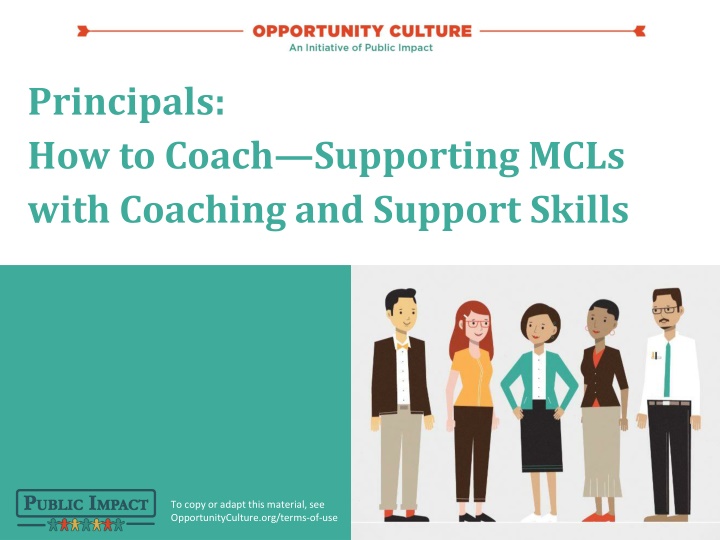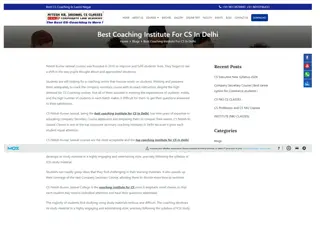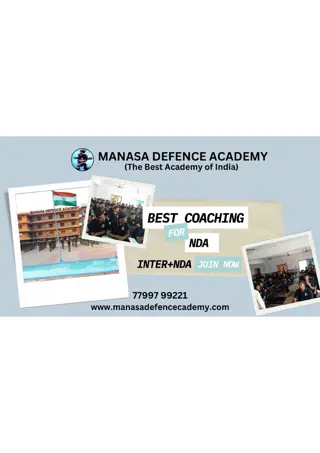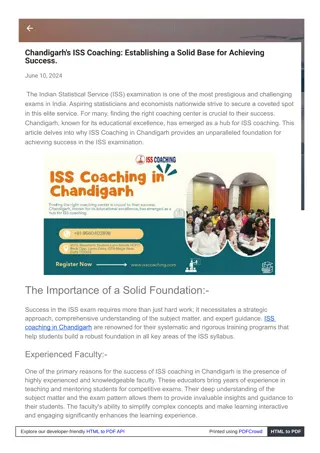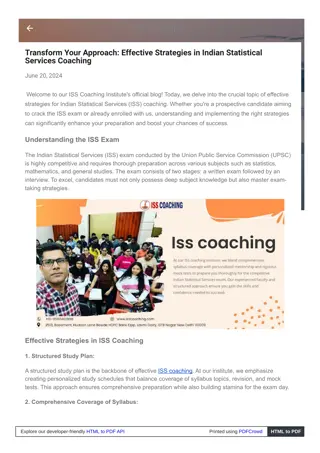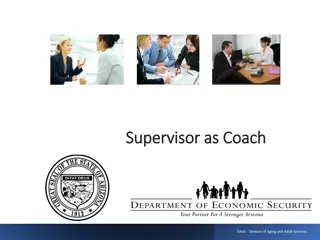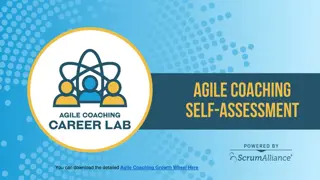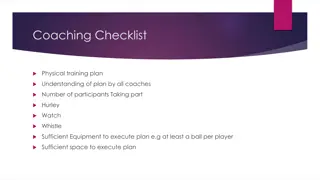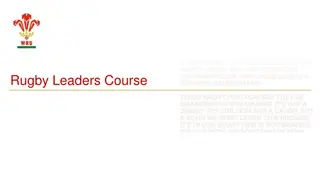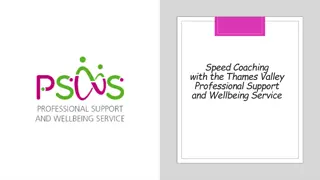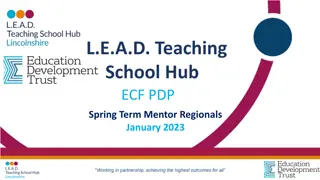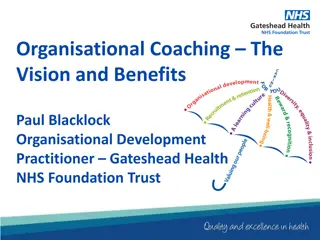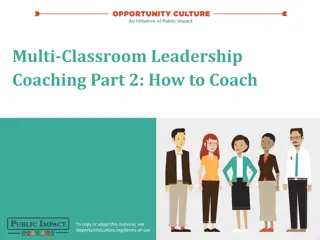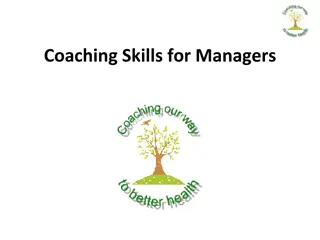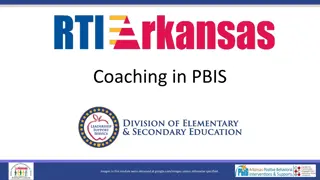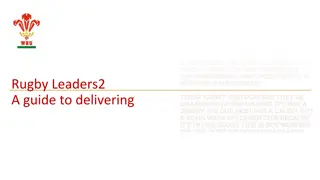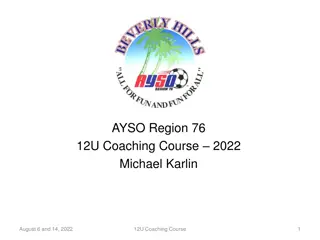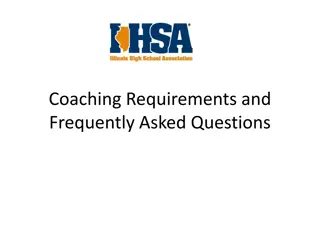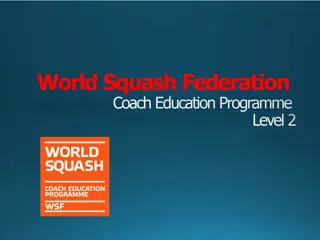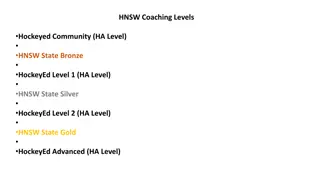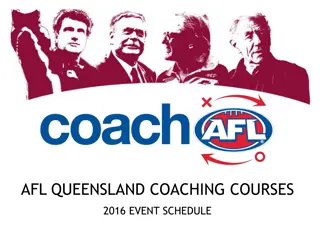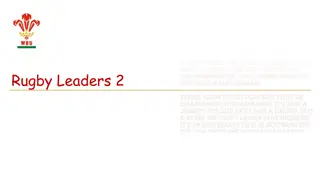Effective Coaching Strategies for Professional Development
Coaching plays a vital role in professional development, focusing on helping adult learners enhance their practices. This article explores the difference between coaching and feedback, outlines the components of a coaching cycle, and provides insights on delivering effective feedback. Practical examples and steps for planning coaching conversations with teacher leaders are included, emphasizing the importance of building relationships, setting visions, and providing interventions as needed.
Download Presentation

Please find below an Image/Link to download the presentation.
The content on the website is provided AS IS for your information and personal use only. It may not be sold, licensed, or shared on other websites without obtaining consent from the author.If you encounter any issues during the download, it is possible that the publisher has removed the file from their server.
You are allowed to download the files provided on this website for personal or commercial use, subject to the condition that they are used lawfully. All files are the property of their respective owners.
The content on the website is provided AS IS for your information and personal use only. It may not be sold, licensed, or shared on other websites without obtaining consent from the author.
E N D
Presentation Transcript
Principals: How to Coach Supporting MCLs with Coaching and Support Skills To copy or adapt this material, see OpportunityCulture.org/terms-of-use 2019 |1
Do Now In your experience being coached or coaching others, how would you define coaching? 2019 |2
Session Objectives Discuss components of a coaching cycle and the Six Steps for Delivering Effective Feedback. Practice identifying coaching strengths and areas for improvement. Apply the Six Steps to practice planning a coaching conversation with teacher leaders. 2019 |3
What is Coaching? Coaching is professional development. Its purpose is to help an adult learner improve their practice. A coach is a facilitator of someone else s learning. - Elena Aguilar, author of The Art of Coaching 2019 |4
Coaching vs. Feedback What is the difference between feedback and coaching? What role can feedback play in coaching? Feedback Coaching Helps individuals be aware of strengths and areas of growth. Leads to acceptance that something needs to change. Helps individuals achieve the new goals that feedback helped them set. 2019 |5
The Coaching Cycle Build relationship, set vision, and norm on roles and expectations Observe teaching, looking for implementation of action steps Facilitate debrief conversation to deliver feedback and identify action step(s) Provide interventions, as needed (such as model lesson, co-teach, etc.) 2019 |6
ThinkPairShare Build Guiding Question: How does this coaching cycle compare to your definition of coaching? To what extent is this coaching cycle similar or different to the coaching already taking place at your school? relationship Facilitate debrief conversation Observe teaching Provide interventions 2019 |7
Six Steps for Effective Feedback A framework from Bambrick-Santoyo s book Leverage Leadership 2019 |8
Coaching Demonstration Bambrick-Santoyo, Paul (2012). Leverage Leadership: A Practical Guide to Building Exceptional Schools. San Francisco: Jossey-Bass. 2019 |9
Discussion: Coaching Conversation Guiding Questions What are the strengths of this coach and the structure of the conversation? How could the conversation be improved? How does this compare to the coaching conversations that occur at your school? 2019 |10
Six Steps for Effective Feedback See Handout Name it See it Action Step Praise Probe Plan Ahead Practice Follow-up Do it Bambrick-Santoyo, Paul (2012). Leverage Leadership: A Practical Guide to Building Exceptional Schools. San Francisco: Jossey-Bass. 2019 |11
Action Step Examples Reduce student talking when you re speaking. Don t talk over students. Stop and make eye contact with the student who is talking. Be careful about your pacing so you leave enough time for independent practice. Set a timer to go off with 20 minutes left in the lesson to remind you that you need to begin independent practice. Restate (or have students restate) expectations for entering the classroom, then have them re- enter to set the mood for learning and reinforce good behaviors. Keep students calm as they enter the classroom. Bambrick-Santoyo, Paul (2012). Leverage Leadership: A Practical Guide to Building Exceptional Schools. San Francisco: Jossey-Bass. 2019 |12
Criteria for Action Steps The probe that MCLs ask the team teacher should lead them to identify their own action step. Action steps should: Address a root cause affecting student learning Does the action step address a root cause or a symptom? Be highest leverage Will this help the teacher to develop most quickly and effectively? Be clear and measurable Can anyone understand the action? Can you easily measure if the teacher has made the change? Be bite-sized If you can t make the change in a week, the action step isn t small enough. Bambrick-Santoyo, Paul (2012). Leverage Leadership: A Practical Guide to Building Exceptional Schools. San Francisco: Jossey-Bass. 2019 |13
Application Activity Prepare for an application activity: Listen to the sample coaching conversation Background context: first-year MCL and one of her team teachers Excerpt of one of their coaching conversations As you listen, write down: Strengths of the MCL s coaching conversation Areas for growth Backwards plan: What 1 2 pieces of feedback would you give the MCL to work on for next time? 2019 |14
Application Activity Use the Six Steps to Coach your Coach Praise: What would you highlight as a specific strength for this MCL? Probe: What questions would you ask to lead them to the action step(s) you want them to work on? Action Step(s): What 1 2 action steps would you have them implement in their next coaching conversation? Practice/Plan: How would you support the MCL plan or practice to implement the action step? Timeline: How would you hold the MCL accountable for improvement? Bambrick-Santoyo, Paul (2012). Leverage Leadership: A Practical Guide to Building Exceptional Schools. San Francisco: Jossey-Bass. 2019 |15
Application Activity: Share & Collaborate In a small group (2 3 people), share your Coach Your Coach plan. Give feedback to your partner(s) on: Is the praise specific and purposeful? Does the probe guide the MCL to identify their action step? Is the action step highest-leverage, bite-sized, measurable, and able to be implemented immediately? Is there an opportunity to practice and/or plan for the action step? Is there a timeline and accountability plan? 2019 |16
Practice! Time Allotted Activity 6 minutes Role-play the coaching conversation. Partner 1 is MCL. Partner 2 is team teacher. 2 minutes Debrief the conversation: What was strong about your partner s facilitation of the coaching conversation? What improvement would you suggest? What are you taking away from this role play to implement in your own coaching practice? Switch roles 2019 |17
Next Steps Write down and share a few next steps you commit to incorporating into your work based on your takeaways from this session. Next Steps By Whom By When Notes/ Resources Schedule recurring meetings with MCLs and TRTs both one-on-ones and meetings with all together into your calendar MCLs Draft standard agenda and/or pre-work documents for MCL/TRT meetings Schedule a time to meet with OC teachers to share review and answer questions about the evaluation tool and evaluation process plan. MCLs 2019 |18
Follow Us! Keep up to date on Opportunity Culture with resources and research from Public Impact by following: @OppCulture @PublicImpact Facebook.com/OpportunityCulture Facebook.com/PublicImpact LinkedIn.com/company/public-impact---chapel-hill-nc Subscribe to the quarterly Opportunity Culture newsletters, with content by and for Opportunity Culture educators, and sign up to get Remind messages for them: Remind.com/join/ocnew OpportunityCulture.org/mailing-list/ 2019 |19
